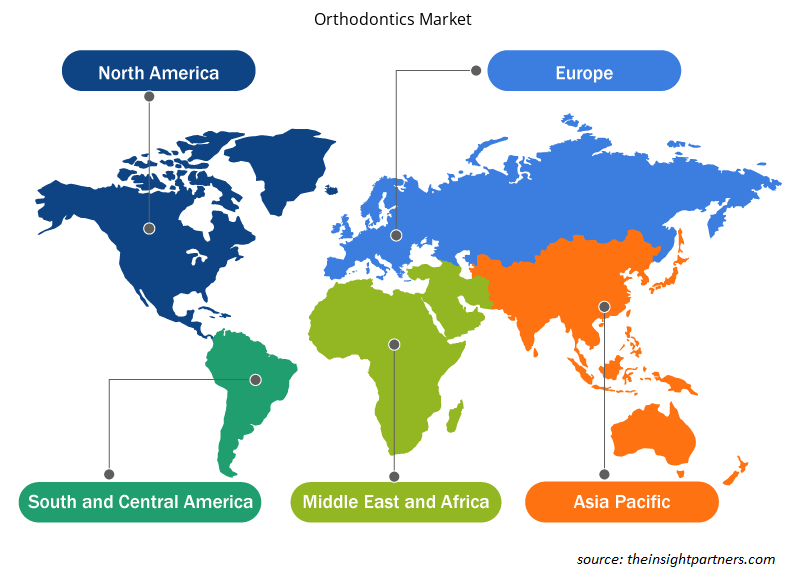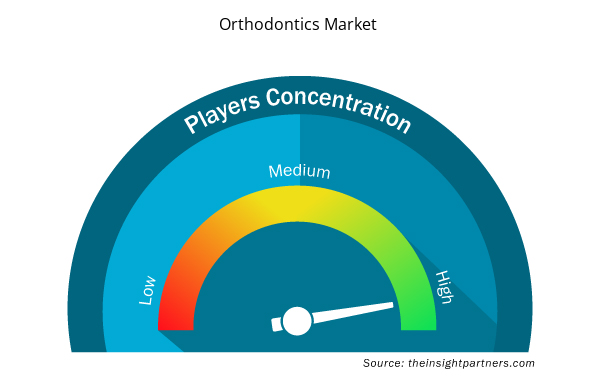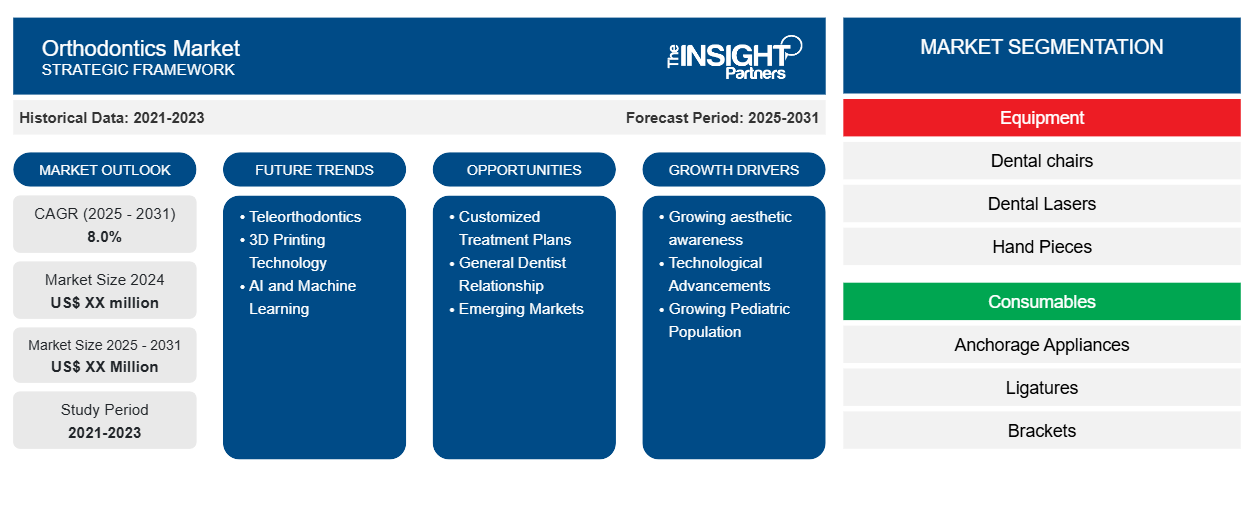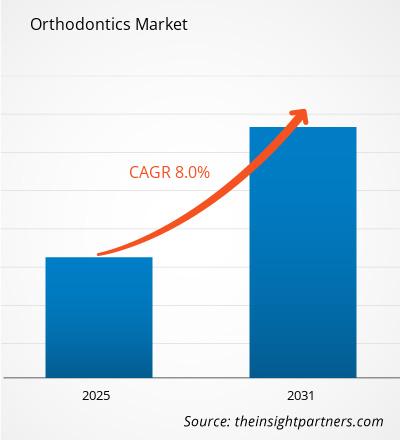Si prevede che il mercato dell'ortodonzia registrerà un CAGR dell'8,0% dal 2023 al 2031, con una dimensione di mercato in espansione da XX milioni di dollari nel 2023 a XX milioni di dollari entro il 2031.
Il rapporto presenta un'analisi basata sulle apparecchiature (poltrone odontoiatriche, laser odontoiatrici, manipoli, fotopolimerizzatori, unità di ridimensionamento, sistemi CAD/CAM, apparecchiature di radiologia odontoiatrica). Il rapporto fornisce inoltre un'analisi basata sui materiali di consumo (apparecchi di ancoraggio, legature, attacchi, archi). L'analisi globale è ulteriormente suddivisa a livello regionale e nei principali paesi. Le dimensioni del mercato e le previsioni a livello globale, regionale e nazionale per tutti i segmenti di mercato chiave sono coperte nell'ambito. Il rapporto offre il valore in USD per l'analisi e i segmenti di cui sopra. Il rapporto fornisce statistiche chiave sullo stato di mercato dei principali attori del mercato e offre tendenze e opportunità di mercato.
Scopo del rapporto
Il report Orthodontics Market di The Insight Partners mira a descrivere il panorama attuale e la crescita futura, i principali fattori trainanti, le sfide e le opportunità. Ciò fornirà spunti a vari stakeholder aziendali, come:
- Fornitori/produttori di tecnologia: per comprendere le dinamiche di mercato in evoluzione e conoscere le potenziali opportunità di crescita, consentendo loro di prendere decisioni strategiche informate.
- Investitori: condurre un'analisi completa delle tendenze in merito al tasso di crescita del mercato, alle proiezioni finanziarie del mercato e alle opportunità esistenti lungo la catena del valore.
- Enti di regolamentazione: regolamentano le politiche e le attività di controllo sul mercato allo scopo di ridurre al minimo gli abusi, preservare la fiducia degli investitori e sostenere l'integrità e la stabilità del mercato.
Segmentazione del mercato dell'ortodonzia
Attrezzatura
- Poltrone odontoiatriche
- Laser dentali
- Pezzi a mano
- Fotopolimerizzazione
- Unità di scala
- Sistemi CAD/CAM
- Attrezzature per radiologia dentale
Materiali di consumo
- Elettrodomestici di ancoraggio
- Legature
- Parentesi
- Archi
Personalizza questo report in base alle tue esigenze
Riceverai la personalizzazione gratuita di qualsiasi report, comprese parti di questo report, o analisi a livello nazionale, pacchetto dati Excel, oltre a usufruire di grandi offerte e sconti per start-up e università
- Scopri le principali tendenze di mercato in questo rapporto.Questo campione GRATUITO includerà analisi di dati che spaziano dalle tendenze di mercato alle stime e alle previsioni.
Fattori trainanti della crescita del mercato dell'ortodonzia
- Crescente consapevolezza estetica: la consapevolezza dell'estetica della dentizione e il desiderio di ottenere sorrisi perfetti nelle persone portano a un aumento della domanda di trattamenti ortodontici. Tutte le fasce d'età, in particolare adulti e adolescenti, cercano di utilizzare di più apparecchi ortodontici o allineatori trasparenti. Una maggiore consapevolezza dell'estetica si traduce in una maggiore domanda di tali trattamenti, spingendo gli studi ortodontici a distribuire i propri servizi e a trovare soluzioni innovative.
- Progressi tecnologici: il trattamento ortodontico nel contesto della tecnologia è stato altamente determinante e influente. Ciò spazia dall'imaging 3D, alla scansione digitale, agli allineatori trasparenti. L'innovazione in ortodonzia riorganizza le possibilità per i pazienti, rendendoli così più efficienti e confortevoli nei processi di trattamento, tuttavia, questo potrebbe presentare maggiori opportunità poiché attrae un'ampia gamma di pazienti, facendo quindi crescere il mercato.
- Crescente popolazione pediatrica: la crescente popolazione pediatrica sta supportando l'espansione del mercato dell'ortodonzia. I genitori sono diventati sempre più attivi nella salute dentale dei loro figli e questo ha portato a una migliore valutazione e trattamento precoci tramite l'ortodonzia, aumentando così la domanda di apparecchi ortodontici e altri dispositivi ortodontici tra le popolazioni più giovani.
Tendenze future del mercato dell'ortodonzia
- Teleortodonzia: la teleodontoiatria sarà presto inclusa nell'ortodonzia. È sempre più utilizzata con la consulenza e il monitoraggio dei trattamenti dei pazienti a distanza, senza richiedere un follow-up diretto intensivo. Ciò contribuisce a una maggiore accessibilità man mano che i costi diminuiscono e questo, a sua volta, ha maggiore attrattiva per i pazienti che richiedono tecnologie elevate e cercano alternative convenienti e attraenti.
- Tecnologia di stampa 3D: i progressi nella tecnologia di stampa 3D stanno trasformando l'ortodonzia, poiché capacità di stampa più rapide e veloci utilizzando apparecchi personalizzati hanno reso possibile ottenere un'elevata accuratezza e precisione in tempi di consegna più brevi, riducendo al contempo i costi, consentendo una migliore gestione dei casi ortodontici in termini di efficienza e personalizzazione per il paziente.
- Intelligenza artificiale e apprendimento automatico: poiché le applicazioni di intelligenza artificiale e apprendimento automatico continuano a crescere nella pianificazione e nella gestione dei trattamenti, possono persino analizzare i dati di un paziente per fornire una previsione specifica ed efficace dell'esito di un determinato trattamento, ottimizzare i piani e valutare il carico di lavoro per una migliore efficienza, rendendo le soluzioni ortodontiche più efficienti e personalizzate.
Opportunità di mercato dell'ortodonzia
- Piani di trattamento personalizzati: è stata identificata una domanda crescente di cure personalizzate. Gli ortodontisti possono offrire un piano di trattamento personalizzato in base alle esigenze e ai desideri del paziente. Gli studi possono ottimizzare il risultato e la soddisfazione con strumenti diagnostici avanzati, insieme ai dati dei pazienti che si traducono in relazioni a lungo termine e fedeltà del paziente.
- Relazione con il dentista generico: l'ortodontista troverà un legame più forte con i dentisti generici, il che aumenta indirettamente le possibilità di pazienti indirizzati e di cure complete per il paziente. I professionisti associati nel co-working possono identificare le esigenze ortodontiche molto prima e intervenire tempestivamente, migliorando così i risultati per il paziente e ampliando il mercato.
- Mercati emergenti: inoltre, ci sono opportunità di espansione in altri mercati emergenti con popolazioni di classe media in via di sviluppo, dove il potenziale di crescita nei servizi e nei prodotti ortodontici è enorme in vista della crescente consapevolezza dell'estetica dentale e dell'aumento dei redditi disponibili. Ciò creerebbe una domanda di opzioni di trattamento efficaci ma accessibili.
Approfondimenti regionali sul mercato dell'ortodonzia
Le tendenze regionali e i fattori che influenzano il mercato dell'ortodonzia durante il periodo di previsione sono stati ampiamente spiegati dagli analisti di Insight Partners. Questa sezione discute anche i segmenti e la geografia del mercato dell'ortodonzia in Nord America, Europa, Asia Pacifico, Medio Oriente e Africa e America meridionale e centrale.

- Ottieni i dati specifici regionali per il mercato dell'ortodonzia
Ambito del rapporto sul mercato dell'ortodonzia
| Attributo del report | Dettagli |
|---|---|
| Dimensioni del mercato nel 2023 | XX milioni di dollari USA |
| Dimensioni del mercato entro il 2031 | XX milioni di dollari USA |
| CAGR globale (2023-2031) | 8,0% |
| Dati storici | 2021-2022 |
| Periodo di previsione | 2024-2031 |
| Segmenti coperti | Per equipaggiamento
|
| Regioni e Paesi coperti | America del Nord
|
| Leader di mercato e profili aziendali chiave |
|
Densità degli attori del mercato dell'ortodonzia: comprendere il suo impatto sulle dinamiche aziendali
Il mercato dell'ortodonzia sta crescendo rapidamente, spinto dalla crescente domanda degli utenti finali dovuta a fattori quali l'evoluzione delle preferenze dei consumatori, i progressi tecnologici e una maggiore consapevolezza dei benefici del prodotto. Con l'aumento della domanda, le aziende stanno ampliando le loro offerte, innovando per soddisfare le esigenze dei consumatori e capitalizzando sulle tendenze emergenti, il che alimenta ulteriormente la crescita del mercato.
La densità degli operatori di mercato si riferisce alla distribuzione di aziende o società che operano in un particolare mercato o settore. Indica quanti concorrenti (operatori di mercato) sono presenti in un dato spazio di mercato in relazione alle sue dimensioni o al valore di mercato totale.
Le principali aziende che operano nel mercato dell'ortodonzia sono:
- Ortodonzia americana
- Società Danaher
- DENTSPLY International, Inc
- Società GC
- Henry Schein, Inc
Disclaimer : le aziende elencate sopra non sono classificate secondo un ordine particolare.

- Ottieni una panoramica dei principali attori del mercato dell'ortodonzia
Punti chiave di vendita
- Copertura completa: il rapporto esamina in modo completo i prodotti, i servizi, le tipologie e gli utenti finali del mercato dell'ortodonzia, fornendo una panoramica olistica.
- Analisi degli esperti: il rapporto è compilato sulla base della conoscenza approfondita di esperti e analisti del settore.
- Informazioni aggiornate: il rapporto garantisce la pertinenza aziendale grazie alla copertura di informazioni recenti e tendenze nei dati.
- Opzioni di personalizzazione: questo report può essere personalizzato per soddisfare le esigenze specifiche del cliente e adattarsi in modo appropriato alle strategie aziendali.
Il rapporto di ricerca sul mercato dell'ortodonzia può quindi aiutare a guidare il percorso di decodificazione e comprensione dello scenario del settore e delle prospettive di crescita. Sebbene possano esserci alcune preoccupazioni valide, i vantaggi complessivi di questo rapporto tendono a superare gli svantaggi.
- Analisi storica (2 anni), anno base, previsione (7 anni) con CAGR
- Analisi PEST e SWOT
- Valore/volume delle dimensioni del mercato - Globale, regionale, nazionale
- Industria e panorama competitivo
- Set di dati Excel



Report Coverage
Revenue forecast, Company Analysis, Industry landscape, Growth factors, and Trends

Segment Covered
This text is related
to segments covered.

Regional Scope
North America, Europe, Asia Pacific, Middle East & Africa, South & Central America

Country Scope
This text is related
to country scope.
Domande frequenti
Adoption of teleorthodontics is likely to remain the key trend during the forecast period.
North America dominated the orthodontics market in 2023
The Orthodontics Market is estimated to witness a CAGR of 8.0% from 2023 to 2031
The market drivers include the growing aesthetic awareness, technological advancements, and growing pediatric population.
Asia Pacific region is likely to witness the fastest growth rate during the forecast period.
American Orthodontics, Danaher Corporation, DENTSPLY International Inc, GC Corporation, Henry Schein Inc, Midmark Corporation, Patterson Companies Inc, Septodont, and Zimmer Holdings
Trends and growth analysis reports related to Life Sciences : READ MORE..
- American Orthodontics
- Danaher Corporation
- DENTSPLY International, Inc
- GC Corporation
- Henry Schein, Inc
- Midmark Corporation
- Patterson Companies, Inc
- Septodont
- Zimmer Holdings, Inc
- 3M Company
The Insight Partners performs research in 4 major stages: Data Collection & Secondary Research, Primary Research, Data Analysis and Data Triangulation & Final Review.
- Data Collection and Secondary Research:
As a market research and consulting firm operating from a decade, we have published and advised several client across the globe. First step for any study will start with an assessment of currently available data and insights from existing reports. Further, historical and current market information is collected from Investor Presentations, Annual Reports, SEC Filings, etc., and other information related to company’s performance and market positioning are gathered from Paid Databases (Factiva, Hoovers, and Reuters) and various other publications available in public domain.
Several associations trade associates, technical forums, institutes, societies and organization are accessed to gain technical as well as market related insights through their publications such as research papers, blogs and press releases related to the studies are referred to get cues about the market. Further, white papers, journals, magazines, and other news articles published in last 3 years are scrutinized and analyzed to understand the current market trends.
- Primary Research:
The primarily interview analysis comprise of data obtained from industry participants interview and answers to survey questions gathered by in-house primary team.
For primary research, interviews are conducted with industry experts/CEOs/Marketing Managers/VPs/Subject Matter Experts from both demand and supply side to get a 360-degree view of the market. The primary team conducts several interviews based on the complexity of the markets to understand the various market trends and dynamics which makes research more credible and precise.
A typical research interview fulfils the following functions:
- Provides first-hand information on the market size, market trends, growth trends, competitive landscape, and outlook
- Validates and strengthens in-house secondary research findings
- Develops the analysis team’s expertise and market understanding
Primary research involves email interactions and telephone interviews for each market, category, segment, and sub-segment across geographies. The participants who typically take part in such a process include, but are not limited to:
- Industry participants: VPs, business development managers, market intelligence managers and national sales managers
- Outside experts: Valuation experts, research analysts and key opinion leaders specializing in the electronics and semiconductor industry.
Below is the breakup of our primary respondents by company, designation, and region:

Once we receive the confirmation from primary research sources or primary respondents, we finalize the base year market estimation and forecast the data as per the macroeconomic and microeconomic factors assessed during data collection.
- Data Analysis:
Once data is validated through both secondary as well as primary respondents, we finalize the market estimations by hypothesis formulation and factor analysis at regional and country level.
- Macro-Economic Factor Analysis:
We analyse macroeconomic indicators such the gross domestic product (GDP), increase in the demand for goods and services across industries, technological advancement, regional economic growth, governmental policies, the influence of COVID-19, PEST analysis, and other aspects. This analysis aids in setting benchmarks for various nations/regions and approximating market splits. Additionally, the general trend of the aforementioned components aid in determining the market's development possibilities.
- Country Level Data:
Various factors that are especially aligned to the country are taken into account to determine the market size for a certain area and country, including the presence of vendors, such as headquarters and offices, the country's GDP, demand patterns, and industry growth. To comprehend the market dynamics for the nation, a number of growth variables, inhibitors, application areas, and current market trends are researched. The aforementioned elements aid in determining the country's overall market's growth potential.
- Company Profile:
The “Table of Contents” is formulated by listing and analyzing more than 25 - 30 companies operating in the market ecosystem across geographies. However, we profile only 10 companies as a standard practice in our syndicate reports. These 10 companies comprise leading, emerging, and regional players. Nonetheless, our analysis is not restricted to the 10 listed companies, we also analyze other companies present in the market to develop a holistic view and understand the prevailing trends. The “Company Profiles” section in the report covers key facts, business description, products & services, financial information, SWOT analysis, and key developments. The financial information presented is extracted from the annual reports and official documents of the publicly listed companies. Upon collecting the information for the sections of respective companies, we verify them via various primary sources and then compile the data in respective company profiles. The company level information helps us in deriving the base number as well as in forecasting the market size.
- Developing Base Number:
Aggregation of sales statistics (2020-2022) and macro-economic factor, and other secondary and primary research insights are utilized to arrive at base number and related market shares for 2022. The data gaps are identified in this step and relevant market data is analyzed, collected from paid primary interviews or databases. On finalizing the base year market size, forecasts are developed on the basis of macro-economic, industry and market growth factors and company level analysis.
- Data Triangulation and Final Review:
The market findings and base year market size calculations are validated from supply as well as demand side. Demand side validations are based on macro-economic factor analysis and benchmarks for respective regions and countries. In case of supply side validations, revenues of major companies are estimated (in case not available) based on industry benchmark, approximate number of employees, product portfolio, and primary interviews revenues are gathered. Further revenue from target product/service segment is assessed to avoid overshooting of market statistics. In case of heavy deviations between supply and demand side values, all thes steps are repeated to achieve synchronization.
We follow an iterative model, wherein we share our research findings with Subject Matter Experts (SME’s) and Key Opinion Leaders (KOLs) until consensus view of the market is not formulated – this model negates any drastic deviation in the opinions of experts. Only validated and universally acceptable research findings are quoted in our reports.
We have important check points that we use to validate our research findings – which we call – data triangulation, where we validate the information, we generate from secondary sources with primary interviews and then we re-validate with our internal data bases and Subject matter experts. This comprehensive model enables us to deliver high quality, reliable data in shortest possible time.


 Ottieni un campione gratuito per questo repot
Ottieni un campione gratuito per questo repot